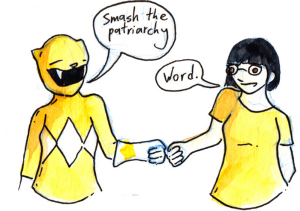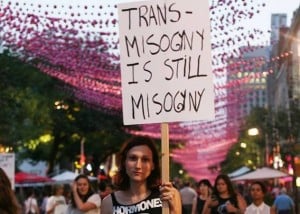This video is part of a series for Everyday Feminism, a website dedicated to helping you stand up to and break down everyday oppression.
When I think of topics I’d want to discuss with ultra-conservative family members, affirmative action is probably at the bottom of my list (right next to police brutality and immigration reform). I’m sure we’ve all heard comments before from people saying things like, “Slavery ended a long time ago, so why are Black people still reaping the benefits?” or “Affirmative action discriminates against White people. Isn’t that *dun dun dun* reverse racist?”
Affirmative action is often accused of being a racist system and this is usually based on the assumption that we live in a post-racist society, meaning racism is no longer an issue in the United States. If racism no longer exists, then why do we need programs that only benefit racial minority groups? Doesn’t that exclude hardworking White people from jobs, schools, and financial aid in lieu of less deserving people of color?
Let’s break down this troublesome myth.
First, I want to give you guys a little history lesson about affirmative action – namely, about what we usually don’t refer to as affirmative action.
The period directly following World War II was a period of huge economic growth for the US, as well as for the expansion of the middle class. Thanks to the GI Bill, which was a bill passed that gave a range of benefits to returning World War II veterans, many US citizens were afforded upward mobility for the first time.
Recipients of the GI Bill received reduced-cost mortgages, low-interest loans so they could start their own businesses, free or reduced cost tuition and housing for universities and trade schools, as well as one year of unemployment compensation. Between 1944 and 1949, almost 9 million veterans received $4 billion in unemployment compensation and by 1962, $50 billion in loans.
Another large source of assistance provided to Americans post World War II came from the creation of the Federal Housing Administration, or the FHA. The goals of the FHA were to improve housing standards and conditions, finance homes at affordable rates, and increase the size of the housing market. Because of this government agency, homeownership increased between 1934 and 2001 from 40% to 70%.
The GI Bill and the Federal Housing Administration were arguably some of the largest affirmative action programs in US history, but they aren’t perceived that way in retrospect largely because they predominantly benefited White Americans.
When programs and policies largely benefit White people, they generally aren’t considered affirmative action, much like the way financial aid and tax breaks received by middle and upper-class people aren’t perceived as welfare. Because of the GI Bill and the FHA, masses of White veterans were able to buy houses, start their own businesses, and gain access to higher education, which up until that point had been a luxury afforded only to a few upper-class elites.
The thing about the GI Bill and the FHA is that they were extremely racist institutions. When World War II ended, veterans of color experienced numerous obstacles in receiving the same benefits as White veterans. Black soldiers were dishonorably discharged after serving the United States at suspiciously high rates compared to White soldiers.
This made them ineligible for any of the benefits of the GI Bill. The soldiers who weren’t dishonorably discharged were largely excluded from job training programs for careers in high-paying fields. Instead, Black veterans were channeled into low paying, traditionally designated “Black jobs.” In Mississippi, 92% of of unskilled jobs designated by the employment service were filled by Black veterans.
On top of this, segregation was still in place, excluding Black veterans from attending the best universities. And unfortunately, the few traditionally Black colleges in the US were ill-equipped, underfunded, and unable to enroll the 70,000 Black veterans who returned from the war. The educational gap between White Americans and people of color increased greatly during this time period.
The Federal Housing Administration was also unapologetically in favor of racial segregation in neighborhoods and actively banned people of color from moving into White neighborhoods. If a person of color did happen to gain access to one of these neighborhoods, the property value of the area went down. In a process called redlining, neighborhoods with high populations of people of color were denied loans and were considered “high risk investments.”
During this time period, only about 2% of federally insured home loans were given to African Americans. Because of the decreased property values of communities of color, these neighborhoods were less likely to receive funds and public services – and often fell into decay.
The problem with discussing affirmative action as if racism is a problem of the distant past is that we ignore the very real effects that racist systems still have on people of color.
So often when I hear people bemoaning the injustice of affirmative action programs against White people, they fail to account for the very long history of racism that has disproportionately elevated White Americans and given many of them the benefits that they receive today. Affirmative action helped millions of White families gain access to higher education, receive high-paying jobs, and buy homes for the first time ever. We can’t ignore the fact that entire racial groups were denied that same privilege.
In 2015, we still see a large gap between the distribution of wealth of White homes and homes belonging to people of color. Residential segregation in neighborhoods exists as a direct result of these policies. Large gaps in education and wage earnings between White people and non-White people are also still largely prevalent. When we connect the injustices that people of color experienced in the past with the injustices that still plague them today, this becomes more than just mere coincidence.
I think much of the time, claims of affirmative action being discriminatory are used to invalidate the success of people of color, but are also used as an excuse to maintain the status quo. White people have had a place at the top for a very long time, and sometimes when we make room for minority groups, it can be perceived as something being taken away from them.
With the creation of affirmative action programs, spaces in society that have historically been reserved for White Americans are meant to be made more inclusive of people of color so that everyone can have an equal and fair chance.
If you are a part of a group that has benefited from discrimination in the past and are used to receiving more than your fair share of opportunities, it can be easy to view affirmative action as something that is harmful to you. But it’s important to remember that affirmative action is merely a response to the discrimination that already exists and has existed for centuries against people of color in the United States.
Affirmative action is not meant to discriminate against White people. It is meant to reverse the discrimination that has denied people of color an equal place in society for hundreds of years.
Sources:




















